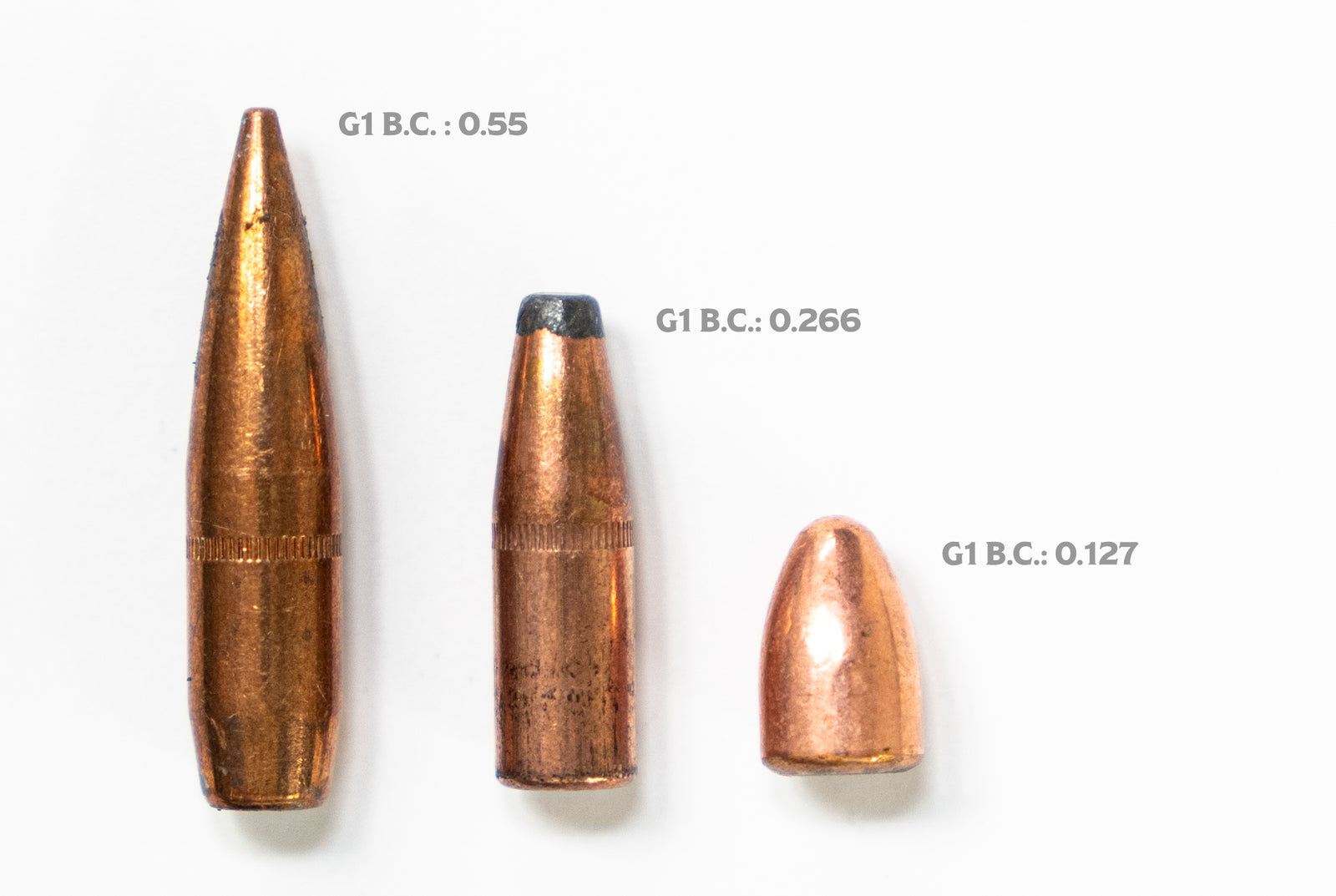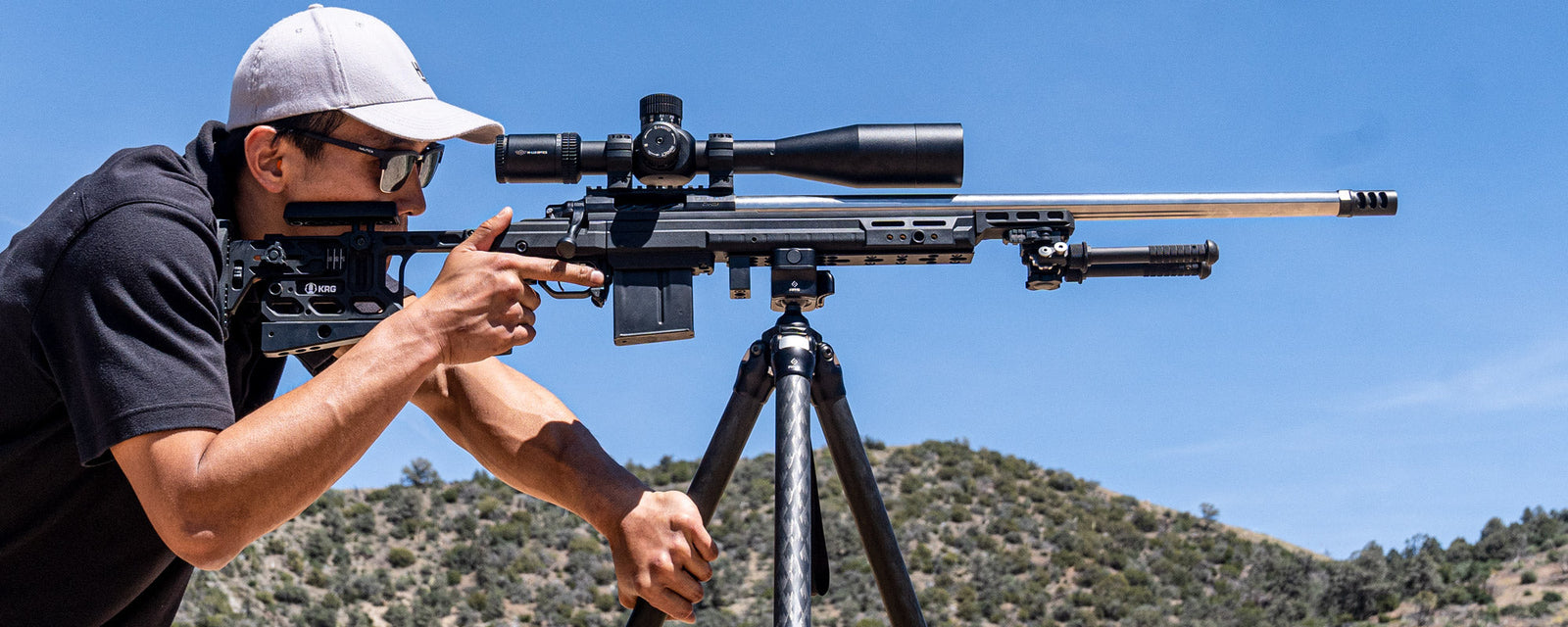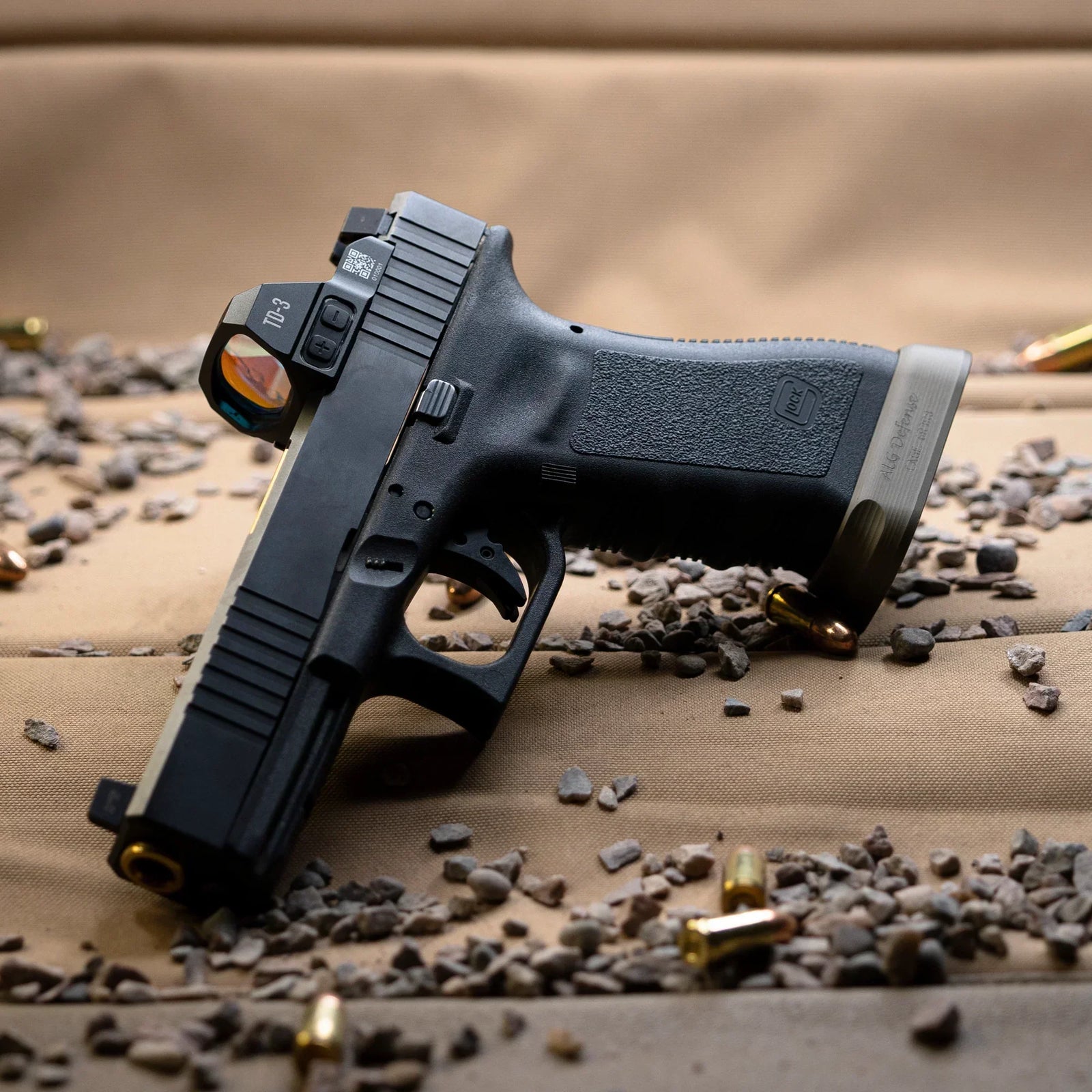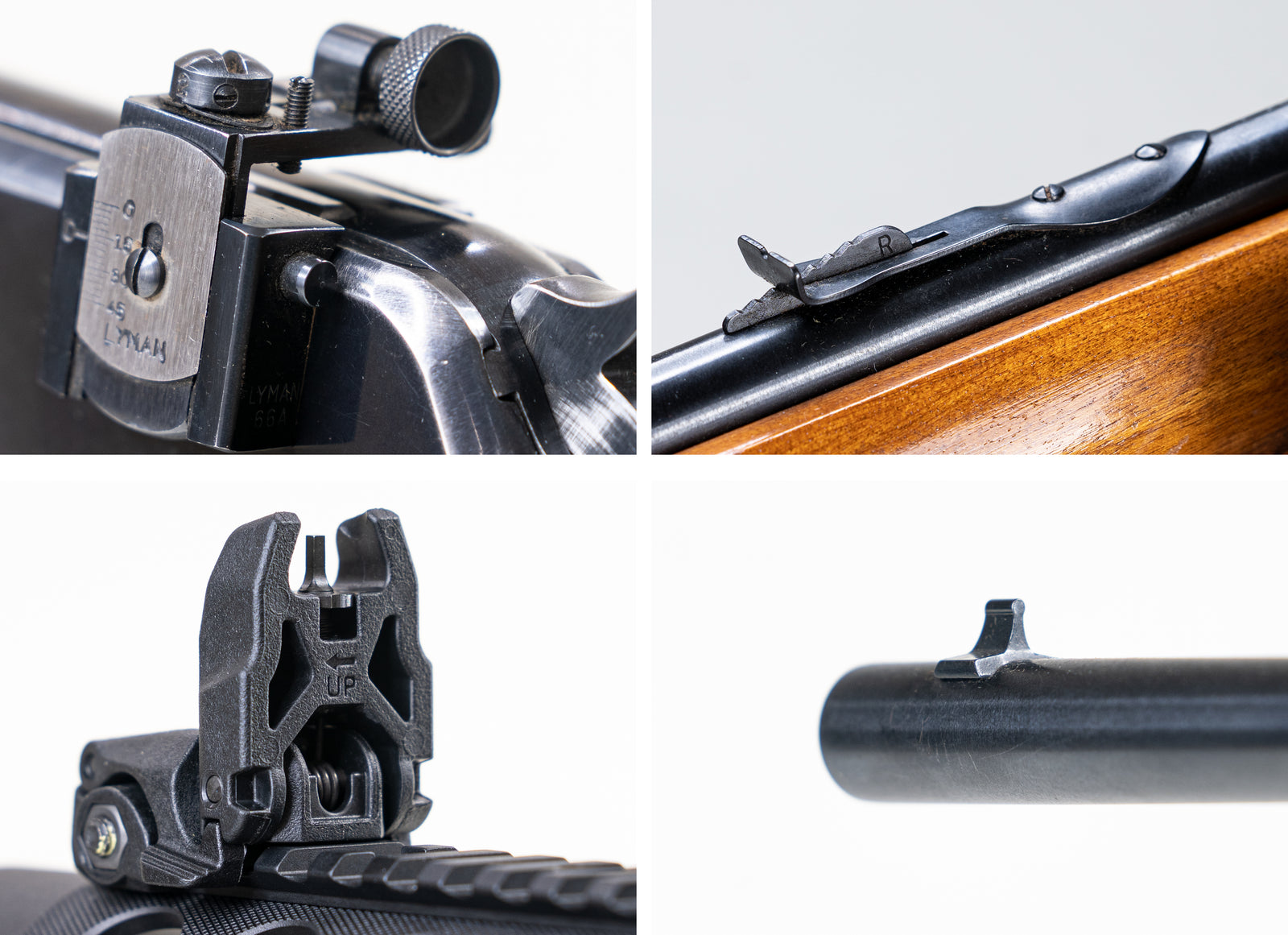One term you’ll hear thrown around quite often is BC. BC is the Ballistic Coefficient, a rather important number in the world of bullet flight efficiency. A higher BC means a bullet will retain velocity better - have less negative acceleration, less drag from the air resistance - in similar conditions to a low BC bullet. A low BC means a bullet is going to start slowing down quickly, losing energy in the process. This may not always matter in target shooting, but it helps determine a maximum ethical distance for hunting when paired with factors like your bullet weight. Another way to look at it - a long ogive bullet is very aerodynamic and will have a high BC. A blunt bullet flies like a brick and has a low BC.

As an example - my favorite cartridge, the .45-70, has a very blunt tip. Actually, the nose is flat across half the diameter (for reasons you’ll read about in another article). It’s also quite heavy, and relatively short for its thickness. The bullet’s diameter is .458” (nearly a half inch!) and they’re generally only about an inch long. This is a short, wide hunk of metal flying through the air. It does not fly elegantly... more like a train. The specific bullet I like has a BC of about 0.281. This is a rather low number. The bullet sheds speed like a sieve, quickly dropping below the speed of sound. Other bullets, such as .30 caliber precision shooters, have BCs of at least 0.5. Some even have a BC well over 0.75! What my bullet lacks in aerodynamics, it makes up for in sheer weight when it meets the target.
BC will also come into play when determining how far the wind will push your bullet side-to-side. A higher BC bullet will glide through the air with little change from the wind. A low BC bullet is a raft on a stormy sea.
Unless you’re hunting, BC is merely a useful way to understand how your bullet will travel. For hunting purposes, BC can factor into the amount of energy on impact. If you’re just shooting steel or paper, the only important factor is that your bullet gets to where you need it to be. Consistency is more important than high numbers. Whatever BC your bullet has, make sure your bullets are the same from one to another. If you know how your bullet moves through the air, you can accommodate the wind and the gravity to get it to the target. A low BC bullet simply requires some extra accommodation.
Let’s run a few numbers. Assuming each of the following bullets are the same weight (175 gr), diameter (.308 caliber), and leave the muzzle at the same speed (2700 fps), let’s see how a change in the BC affects the drop down range. The rifle is set up to hit the target perfectly at 100 yards, right where the crosshairs are aiming. We’ll compare the relative drops (in bold) and velocities between bullets with a BC of .250, .500, and .750. In italics below, I’ll also list how much the bullet will turn away from the centerline under a direct 10 mph wind. The angular measurements (given in Minutes of Angle, Chapter 5.3.1) will be accompanied by their equivalent linear size at that distance.
[Drop, velocity, windage]
|
Distance (yards) |
.250 BC |
.500 BC |
.750 BC |
|
200 |
2.3 MOA, 4.8” 2029 fps 2.9 MOA, 6.1” |
1.9 MOA, 4.0” 2351 fps 1.4 MOA, 2.8” |
1.8 MOA, 3.7” 2464 fps 0.9 MOA, 1.9” |
|
400 |
10.3 MOA, 43.2” 1467 fps 6.8 MOA, 28.5” |
7.6 MOA, 31.8” 2023 fps 2.9 MOA, 12.2” |
6.9 MOA, 28.9” 2237 fps 1.9 MOA, 7.8” |
|
800 |
44.0 MOA, 368.6” 923 fps 16.8 MOA, 141.1” |
24.2 MOA, 203.1” 1463 fps 6.8 MOA, 57.3” |
20.2 MOA, 169.2” 1820 fps 4.1 MOA, 34.4” |
|
1000 |
71.8 MOA, 752.2” 818 fps 21.4 MOA, 224.2” |
36.1 MOA, 377.9” 1247 fps 9.2 MOA, 96.6” |
28.5 MOA, 298.6” 1632 fps 5.4 MOA, 56.7” |
While it’s easy to guess that the more aerodynamic bullet (higher BC) will fly better, it’s impressive to see just how much. The more aerodynamic the bullet, the better it’ll retain speed as it travels down range. It won’t drop as much, nor get pushed as much by wind. All 3 bullets started with the same muzzle velocity. Only one dropped below the speed of sound before it reached 1000 yards.
Ballistic calculations are based on a number of different drag curve models. A drag curve model is a calculation of aerodynamic efficiency based on a bullet’s shape. In other words, it’s a model for how a bullet should behave in regards to drag from the air. To simplify calculations, a handful of theoretical standard bullet shapes have been devised and assigned calculations.
The standard bullet shapes are each assigned a code starting with the letter “G”. They range from G1-G8, and GL. Each G# combination tells the calculator the proper drag equation to use depending on your bullet’s shape. The most commonly used are G1 and G7, but I’ll list other semi-common options below in case you come across them when trying out new rounds.
G1 : “Ingalls”. A bullet with a flat base and a relatively blunt (2 caliber ogive) nose. The most popular number provided by bullet manufacturers, but not actually the most common shape in long-distance riflery. It looks closer to a modern handgun bullet.
G2: “Aberdeen J Projectile”,
G5: Bullet has a short 7.5° boat tail and 6.19 caliber long tangent ogive
G6: Flat base, 6 caliber long secant ogive
G7: Long 7.5° boat tail, 10 caliber secant ogive. One of the more common shapes for “very low drag” bullets. This is also often the correct coefficient for modern rifle rounds, though manufacturers will not often list this value.
G8: Flat base, 10 caliber long secant ogive
GL: Blunt lead nose

Please be aware that ballistic coefficients are a means of calculating ballistic trajectories while firing less rounds than in the past. Traditionally, you’d simply fire many times at many distances and figure out drop and wind movement by hand, using the specific round that you’d be testing. Modern calculations are based around a fictitious or standard projectile, which has been tested and refined over time. Knowing your BC is useful in figuring out how your bullet may fly, but it’s only a theoretical number. It’s used for calculations and approximations. Your math may tell you that your bullet should behave a specific way under certain conditions, and yet your bullet moves differently than expected. More than anything else, trust the bullet. If your bullet is dropping more than your math says it should, then it doesn’t matter what your math says. Adjust your aim and continue firing.
While you can do the math by hand, running the data on your load through a ballistic calculator will dramatically reduce the effort required. A range of free websites and somewhat free apps have been developed to run the numbers for you. The more accurate information that you can provide to your calculator or notebook, the more helpful the final ballistic data will be.
I find myself using JBM Ballistics quite often. Their calculator can be found at jbmballistics.com

As an aside (though a very important one) - most manufacturers will list their bullets’ BCs in G1 terms. Strictly speaking, this is often not correct. Most modern very low drag (VLD) bullets are shaped like a G7 projectile, which is not nearly as blunt as the G1. Plus, there’s usually a boat tail. Manufacturers will list a G1 coefficient for two reasons: it’s the most common equation, and the number is bigger. Bigger numbers make for more impressive marketing. Switching the calculations over to the G7 projectile, the math becomes more precise, but the value sounds less impressive on the box. Something to keep in mind.
You can still run the math as though your projectile is a G1 shape, but the charts won’t be as precise as they would be when using the proper BC. As a starting point for figuring out drop estimates, this works well out to 600 yards or so, but anything farther will take some test firing to really dial in. The BC of a G1 projectile will vary as air pressure and velocity changes. Still, it’s close enough to start.
As a general rule, a bullet with a G7 BC of 0.2 has roughly the same drag as a bullet with a G1 BC of 0.4, assuming it’s shaped like a G7 projectile. In other words, the G1 number is roughly double the G7 number.
When looking into ballistic coefficients, you’ll come across much discussion of calibers and ogives. The ogive is the curve leading from the widest portion of the bullet up to the nose. Laid out flat on a paper, it’s possible to draw the ogive as a portion of a circle’s circumference. That particular imaginary circle has a radius. If the radius of that imaginary circle is very large (many multiples of the caliber of the bullet), the curve of the ogive will be very gentle. The bullet will have a long, sharp, slowly tapering tip that is very aerodynamic. If the radius of the circle is small (only a couple calibers in length), the bullet will be very blunt. It’ll have quite a lot of drag across its ogive.
This is the method behind the descriptions of ogive curvature. Ballistic theory will talk about the ogive in terms of calibers. What they are discussing is: for the imaginary circle we just talked about, how many times does the caliber of the bullet fit into the radius of that circle? If the ogive has a radius of 10 calibers, it’s a very flat and long ogive. It’s the edge of a very large circle. If the ogive is just 2 or 3 calibers in radius, it’s a very blunt bullet - the circle is very small, and the curve very sudden. This keeps the shape and proportionality of ogives the same between different calibers. A bullet can have a larger caliber and more weight, but behave the same in regards to air resistance.





Leave a comment (all fields required)